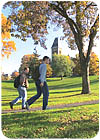
For enterprise security executives aiming to align their operations with information technology needs and business budgets, systems that can run on wire, fiber, radio and Ethernet save installation expenses as well as provide more flexibility.
That’s the lesson of an integrated life safety system at Cornell University.
The 745-acre, 240-building Ithaca, N.Y., campus of Cornell University has become a safer place with an upgraded fire alarm monitoring system that pinpoints information from more than 30,000 points (smoke alarms, heat detectors, etc.). The university’s new Digitize (Lake Hopatcong, N.J.) System 3505 alarm monitoring system identifies and provides details on the alarm source (for example, smoke alarm, building 123, first floor hallway by Room 230). As part of the upgrade, the 10-year-old system was replaced. The older system simply monitored reverse polarity alarms that only identified the building where the alarm originated.
“We had come to the end of life for the old system,“ said Terry Freund, program manager, fire management systems. “We had upgraded it one time before, but the technology available today is significantly enhanced compared to the previous upgrade.”
With the new system, alarm points are sent to Digitize’s Computer Graphics Response and Management System (CGRMS) program for more detailed alarm monitoring and graphic display. A central PC console in the campus’s 911 center will receive detailed alarm information.

Source details
The System 3505 receives alarms and trouble signals from various manufacturers’ fire alarm control panels via Digitize’s Muxpad II. It interprets the signals from the panels and transmits them to the System 3505. The supervised RS-485 signals are multiplexed over telephone wires. A supervisory alarm reports a malfunction, such as a faulty control valve on a sprinkler system or a failed power supply on a smoke detector. A full-blown alarm initiates a response by the Ithaca Fire Department and Cornell campus police. These alarms are also transmitted to alphanumeric pagers worn by key responders. A typical building contains between 200-900 alarm points.In addition, Cornell was able to use the existing wiring, previously used for reverse polarity, to obtain all the addressable alarm information, including the actual panel text message. This helped expedite the process and reduce cost, since Cornell did not have to change to more expensive “data lines.”
“This new system allows us to know point to point hazards – device by device and I can identify definitive information about the device,” commented Freund.
The CGRMS computer terminal displays a map of the particular building, pinpointing the trouble spot and alarm conditions. An icon depicts the type of alarm and CGRMS provides details about that alarm point, such as action to take, whom to notify, time of response and conditions that responders might expect to find. The final campus-wide system will have three CGRMS workstations networked via Cornell’s LAN (local area network).

Safety and compatibility
As part of the new system, Cornell added new point-specific fire alarm control panels to existing buildings. The 3505 functions with all of Cornell’s panels from various vendors. “Compatibility with various fire panel vendors is the key,” added Freund, who also likes the detailed, graphic alarm point information the system provides.Freund said the life safety upgrade is all part of a plan to take the fire alarm system already in place for security via the university police.
While the Cornell installation uses existing hardwire communication, some college, university and medical campuses are running similar systems over Ethernet, radio and fiber networks.

